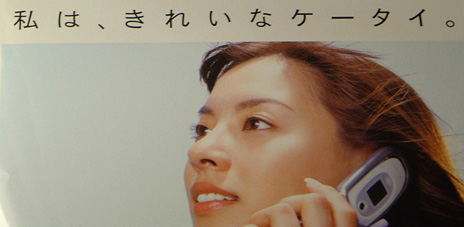Keitai
The Japanese word for a mobile phone or cell phone is keitai
denwa ('portable phone'), written   in Chinese characters. This is how the word is written in correct or formal
prose, including the following:
in Chinese characters. This is how the word is written in correct or formal
prose, including the following:
 Kyakuseki de no keitai-denwa no go-shiyō wa...
Kyakuseki de no keitai-denwa no go-shiyō wa...
The use of mobile telephones at tables is... |
In popular usage this is abbreviated to  keitai ('portable'), as in the following advertisement:
keitai ('portable'), as in the following advertisement:
 0120-324929 (mi ni yo ku tsu ku = mnemonic device
for remembering number)
0120-324929 (mi ni yo ku tsu ku = mnemonic device
for remembering number)
Do, nichi, shuku mo uketsuke!
Keitai, PHS kara mo OK!
0120-32429
Also accept [enquiries, etc.] on Saturday, Sunday, holidays!
[Calls from] mobiles and PHS also OK! |
As a Chinese-style compound read in the on-reading,
keitai should by rights be written in Chinese characters. It is now much
more common, however, to write it in katakana as keetai. This can be found both in informal writing
and in advertising. Examples are easy to find.
keetai. This can be found both in informal writing
and in advertising. Examples are easy to find.
 Watashi, kirei na keetai
Watashi, kirei na keetai
I [like/have] an attractive/pretty mobile |
 Keetai de totte, meishi o kanri suru.
Keetai de totte, meishi o kanri suru.
Take [a photo, snapshot] with a mobile, manage business cards. |
 Kirei ga hirogaru, ureshii keetai 505i desu.
Kirei ga hirogaru, ureshii keetai 505i desu.
Attractiveness expands, a glad-to-have mobile 505i. |
Notice the very different environments in which keetai
occurs.
- In the first advertisement, the word kirei
'attractive, pretty, clean' is in hiragana. This is quite standard,
but the total effect of Watashi, kirei na keetai
is clean and uncluttered, in harmony with the message of the advertisement.
- In the second (bottom) advertisement, the use of katakana is quite
idiosyncratic, with several words written in katakana which would
not normally be so written. This peculiar usage and the adoption of blue writing
attempts to create a specific overall effect. This ad is trying to be young,
trendy, and approachable for the non-technical user.
- By contrast, the advertisement on the right is, with the exception of the
word
 keetai itself, written in quite standard script with heavy use of Chinese
characters, including the use of a character to write the Japanese verb toru.
This, more than the other two advertisements, brings home how widely
keetai in katakana is now accepted in Japanese.
keetai itself, written in quite standard script with heavy use of Chinese
characters, including the use of a character to write the Japanese verb toru.
This, more than the other two advertisements, brings home how widely
keetai in katakana is now accepted in Japanese.
Why the massive shift to ? There
are several elements involved. ? There
are several elements involved.
1. The characters  are relatively difficult and, more importantly, troublesome to write. The temptation
to simplify is overwhelming.
are relatively difficult and, more importantly, troublesome to write. The temptation
to simplify is overwhelming.
2. Chinese-style compounds rely on Chinese characters to convey their meaning.
In general there is psychological resistance to writing such compounds in anything
but Chinese characters. However, by dropping the word denwa
'telephone' and passing into mass usage, keitai
has become an informal, everyday spoken word,
an identifiable phonetic shape in its own right independent of the characters
that make it up. There is thus much less psychological resistance to a phonetic-style
script (katakana) in place of characters.
3. Hiragana would be possible, but has two problems: unlike katakana,
it fails to make the word keitai stand out from
the surrounding text, and it looks childish. Katakana is the obvious
choice.
The following are the results of a Google search in September 2003:
| Form |
No. of occurrences |
 |
4,570,000 |
 |
1,930,000 |
 |
11,000 |
(Note, however, that  'mobile, portable' is found in a wide range of words, not merely in
'mobile, portable' is found in a wide range of words, not merely in   keitai denwa.)
keitai denwa.)
|




